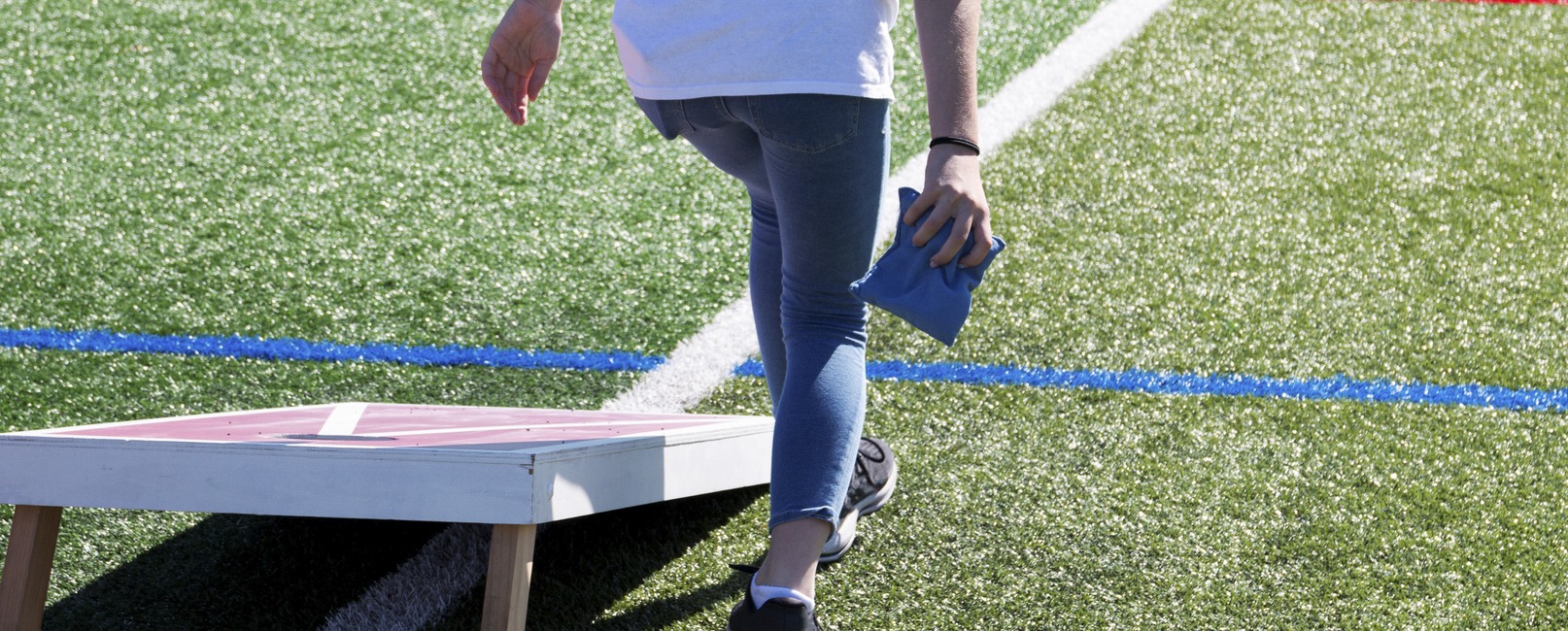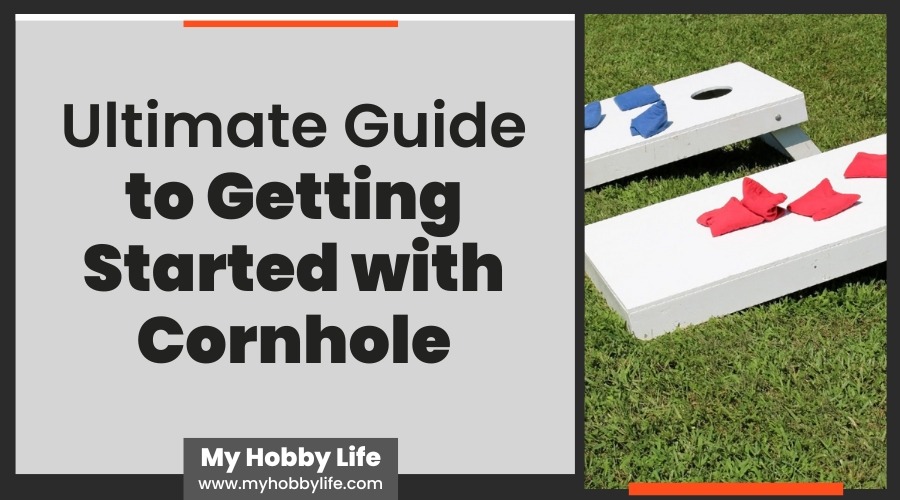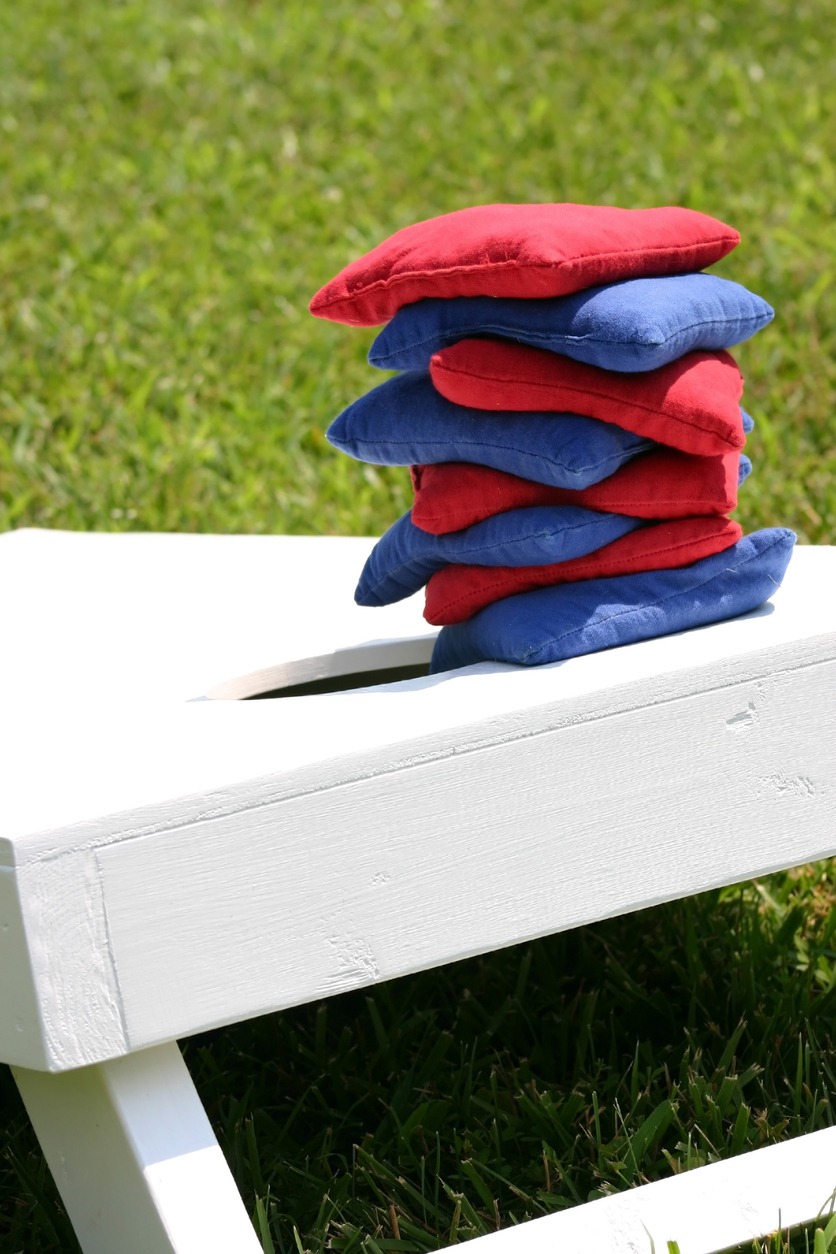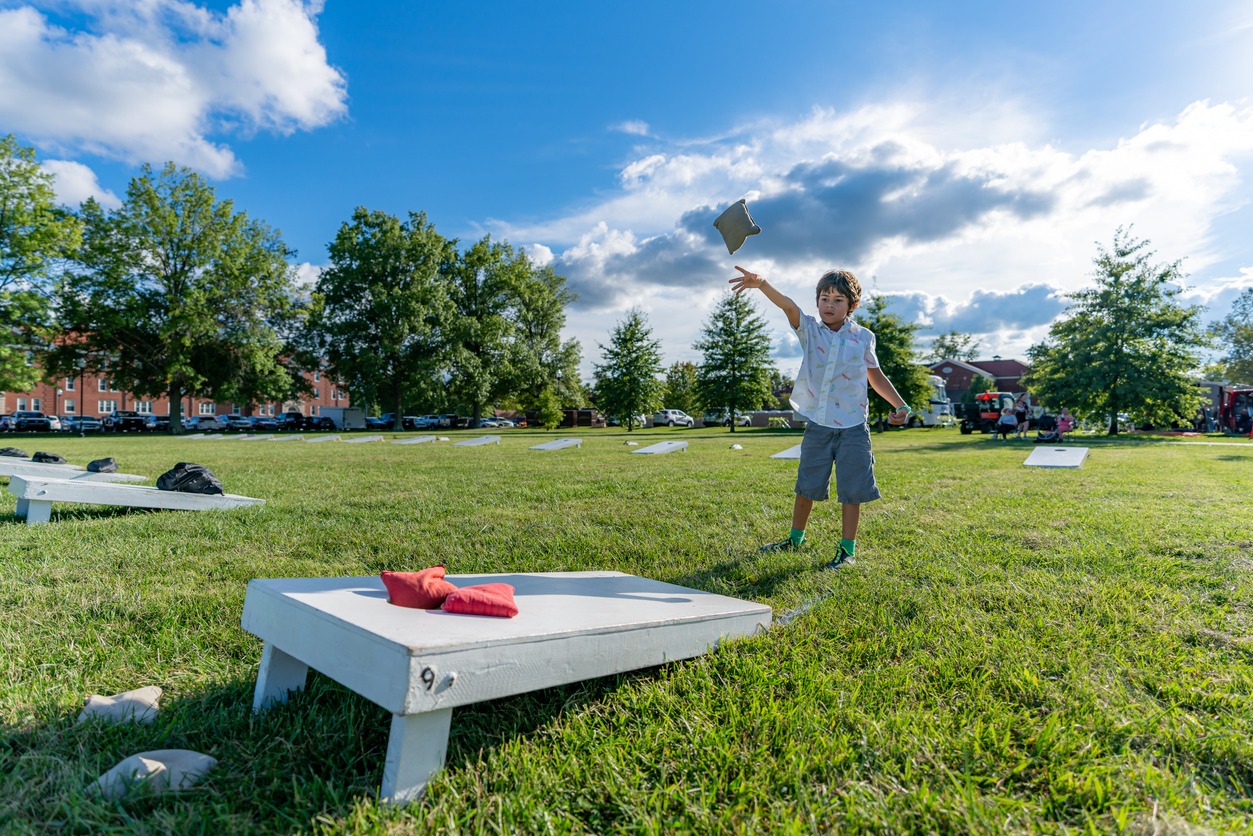In the US, cornhole is a common outdoor game. Even though it has only lately emerged as a popular form of entertainment, this family-friendly activity has a long history.
Cornhole is a straightforward game that is also referred to as bean bag toss, soft horseshoes, tailgate toss, baggo, and bags. It’s a terrific game for players of all ages and skill levels because the rules and gameplay are simple to comprehend.
The official cornhole game may be played almost any place with a minimum of equipment. Due to its adaptability, cornhole has developed into a requirement for well-liked events like tailgating and backyard barbecues.
What is Cornhole and How is it Played?
The game of cornhole is usually played outside. Players toss sacks of corn at raised platforms (boards) with holes in the middle, similar to horseshoes. The goal of the game is to throw your bags so that they land on the platform or within the hole in order to collect points. When you have some friends over and want to take advantage of the pleasant weather, this game is ideal. Plus, anyone can participate in the fun because playing is so simple to learn.
The fundamentals of cornhole are quite straightforward. To start, you and your opponent take turns throwing bags at the boards. Depending on where your bag lands, you score points. You receive 1 point for tossing a bag that lands on the boards. You score three points if your bag falls into the hole. Your luggage has no value if it falls to the ground. The match is won by the first player to accumulate 21 points.
Choose an Appropriate Location
It’s crucial to select a location that’s largely flat and devoid of obstructions when playing Cornhole outside. This will make it more likely that the bags will remain in the gaming area and not fall into the neighboring shrubs or trees.
Make sure there is plenty of space for people to move around because cornhole can be a really dynamic game. To avoid players rushing into the borders when sprinting downcourt after scoring, for instance, if you’re playing in a closed space like a park or backyard, make sure the boundaries are marked.
Cornhole Equipment
You only need the following to play cornhole:
1. Cornhole Boards
You will need a good set of cornhole boards as your first item. These are really simple to build on your own. However, you may also purchase them online for a reasonable price.
The American Cornhole Association has established a standard for the dimensions of the board’s hole, including its length, angle, and size. Although a board made to the appropriate specs is usually more enjoyable, some players also create smaller, more manageable boards for younger players.
The board face should be 2 feet broad and 4 feet long with a 6′′ hole cut out of it. The hole’s center must be 12′′ from the board’s side and 9′′ from the board’s top. The board’s end with the hole should be raised 12″ off the ground. Usually, the board face is constructed of 1/2′′ plywood, while the frame is made of 24s.
2. Cornhole Bags
A typical cornhole bag will be a 6-by-6-inch square with sewn seams on all four sides. Each bag must contain roughly 2 cups of feed corn and weigh 14 to 16 ounces (1 pound). According to the ACA (American Cornhole Association), the bags will be made of sturdy fabric.
As the bags measure 6 by 6 inches, it is easiest to use 6 1/4-inch pieces of fabric and stitch them together with the extra 1/4-inch. This is generally not a problem if you purchase a cornhole board because quality sets include official cornhole bags.
3. Cornhole Layout
You already have the boards and the bags; all that is left to do is set up the corn hole field. A legal cornhole field must be flat and at least 40 feet long by 10 feet wide. You shouldn’t worry about the specifics when playing in your backyard.
The required distance between cornhole boards is 27 feet, measured from board front to board front. For both players, the front of the board serves as a foul line. Up to 12 feet can be added to the youth foul line’s distance.
The pitcher’s box is usually 2 feet by 4 feet in size and is situated on either side of both cornhole boards. No one has ever even brought up a pitcher’s box. However, the foul line will cause controversy because even your hand cannot cross it.
How to Play Cornhole
In a typical game of cornhole, there are two teams of two players each. With a few minor adjustments, 1 player per team (1 on 1) can be played. Try to play with four players if you can; it makes the game more enjoyable. Playing with 4 players offers you the opportunity to knock your opponents’ bags off the board due to the setup.
1. Player Position
Each cornhole board will have a person from each team standing to the side of it. If you recall, there were two pitchers boxes on either side of each cornhole board in the above-mentioned cornhole field arrangement. Therefore, there will be two opponents positioned on either side of each corn hole board.
Team members must stand facing each other on the same side of the cornhole boards in the typical player position. For instance, the teammates won’t be situated diagonally opposite one another on the field. This prevents any team from having a placement-based edge over another.
2. Bag Distribution
Each team will have 4 identically colored bags. There should be a total of 8 bags in the game, 4 for each team. Typically, your cornhole set will include 8 bags, for instance, 4 red and 4 blue bags. On a single cornhole board, all 8 cornhole bags are placed.
3. Start The Game
The squad that makes the opening pitch is awarded with the honors. The teams usually flip a coin to determine who receives honors. There may be more than one team, in which case the champion team will receive the awards. The victorious team plays the following team waiting for their turn, and so forth.
The honor team will toss a bag first, followed by their rival team. Until all 8 bags are thrown out, this back and forth exchange continues. Following that, the winning team alternates with its rival for all 8 bags before tossing the first bag back to the original starting board.
4. End The Game
A round is defined as when all 8 bags have moved from one cornhole board to the next. There is no cap on the number of rounds that can be played, but the points are added up at the conclusion of each round. When one team scores 21 points or more, the game is over. Popular house rules include things like going over 21 resets your score to 17, winning by 2, and related clauses.
Cornhole Scoring
Traditionally, 21 points are scored in a game of cornhole. You are given:
- If the bag falls through the hole, 3 points.
- 1 point for bags that connect with the board and stay there.
According to cancellation scoring, points are retained. Here is a situation to illustrate:
- The Red Team scores five points in the opening frame by getting two bags on the board and one bag through the hole.
- Two bags go through the hole and one bag ends up on the board, giving the Blue Team a total of seven points.
- The Blue Team must deduct the 5 points earned by the Red Team from their score, giving them a final score of 2 points, as opposed to Blue Team 7 and Red Team 5. In the end, Blue Team would have won by a score of 2 to Red Team’s 0.
No points are awarded for bags that slip onto the board after first hitting the ground.
Some claim that in order to win, you must receive exactly 21 points; if you receive more than that, your score is cut to 11. Others assert that you need to win by two. The ACO contends that this is untrue. The winner is always the first team to achieve 21 at the end of a frame.
Of course, as long as you’re not taking part in an official competition, you’re free to include any restrictions you choose.
Cornhole Tips & Tricks for Beginners
Despite appearing simple, placing a cornhole bag in the hole takes more skill than science. Even though having the ideal arc and slide will almost certainly ensure success, doing it consistently is challenging. If you’re new to the game, use these pointers to sharpen your skills and increase your enjoyment. Make sure you are familiar with the guidelines, work on your catching and throwing techniques, and perfect your aim. You’ll be playing like a pro in no time with these suggestions. Here are some further, in-depth suggestions to assist you:
- To begin, work on your technique in your yard or a park.
- Before playing with others, learn the fundamental rules.
- To make it simpler to hit your target, choose a smaller set of boards.
- To improve your chances of scoring points, aim for the center of the board.
- Try not to get discouraged; everyone has been a beginner before.
Advanced Techniques to Improve Your Game
Now that you are familiar with the fundamentals of cornhole, it’s time to advance your skills. You may wow your pals and get more points by using these sophisticated strategies.
1. Stay consistent
Consistency is the key to becoming a Cornhole pro. You must be able to repeatedly reproduce your greatest throws. Practice is the only way to become proficient in this. In your yard, set up a target, and begin daily bag throwing. You’ll soon acquire the muscle memory required to make accurate shots.
Being consistent with your form and how you release the bag is key when taking your shot. If you employ an overhand throw, for instance, start by holding the bag with both hands in front of your body.
Your other hand should hold the top of the bag while your dominant hand should be holding the bottom.
2. Get your stance down
Your position is important for two reasons:
- It gives you support as you toss the bag.
- Your aim is affected by it. If you’ve never played Cornhole before, begin by standing parallel to the platform (i.e., facing it directly).
Make sure to experiment with various postures until you discover one that’s comfortable to you and provides the most accuracy.
3. Experiment with different throws
You may throw a cornhole bag in a variety of ways, so the best way to figure out which one suits you is to explore. Throws made using the underhand, overhand, and sidearm are a few common tactics. Choose a look that makes you feel good and stick with it.
4. Step forward stance
When starting an underhand throw, place the cornhole bag in front of your body and place one foot in front of the other. Your other hand should be on top and your dominant hand should be at the bottom of the bag. So simply throw it out!
5. Aim is essential
When you first start, it can be tempting to throw the bag as hard as you can in the hopes that it will fall into the hole. However, the goal is far more crucial than strength. Using a delicate touch is the greatest approach to make sure your bag goes in the direction you want it to. Keep your form and release in mind.
6. Add a bit of spin
Try adding spin to your throws if you want to improve your performance. Even while this is a little more difficult, it might help you control the bag’s motion and make those challenging shots. As you release the bag, flick your wrist to add spin.
Cornhole Regulation Rules:
- When throwing, a player must remain in the pitcher’s box.
- When a throw is being made, a player’s hand may not cross the foul line.
- If a bag rebounds onto the board after colliding with the ground, it is out and needs to be taken off.
- Players cannot throw outside of their turn
- The foul line must not be crossed by a player’s foot.
- The player loses the bag and it is taken off the board if a foul occurs during a throw.
The most frequent foul occurs when someone tosses a bag while their foot is in front of the cornhole board. In this situation, the throw is deemed to be invalid, and if the bag lands on the board, it is removed.
Conclusion
A game called cornhole has been played for many years and is still very popular today. It is always enjoyable to play, whether you are doing so in your garden or at a tailgate party. The game has advanced significantly throughout the years, and it doesn’t appear that it will soon slow down. No matter if you play for fun or for a prize, cornhole is always enjoyable.



